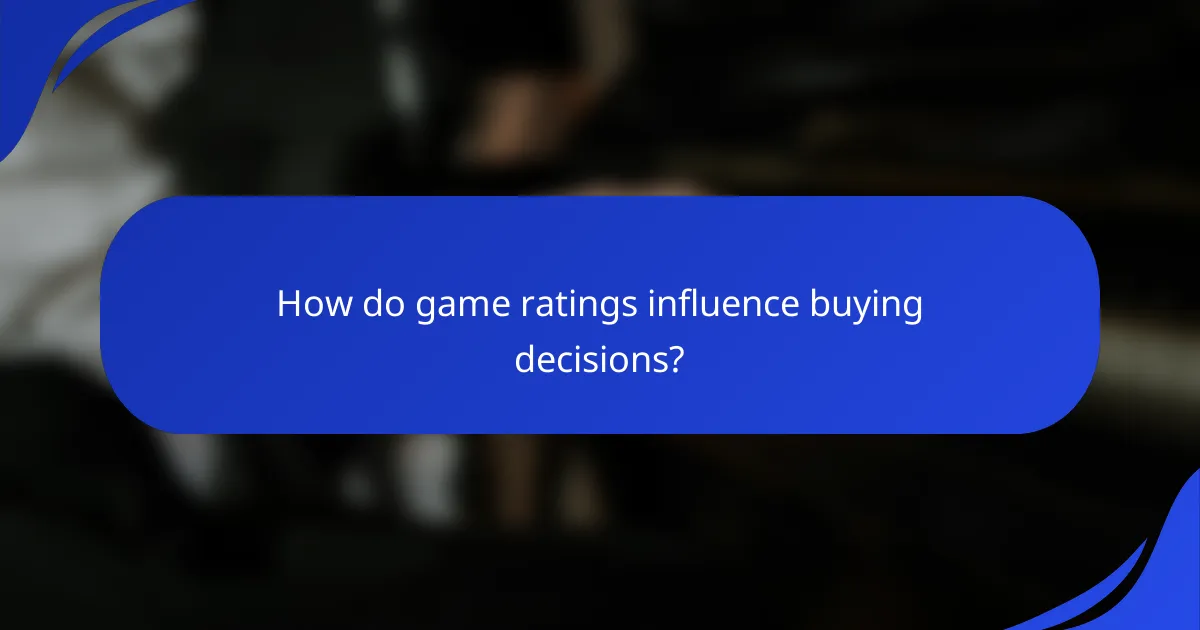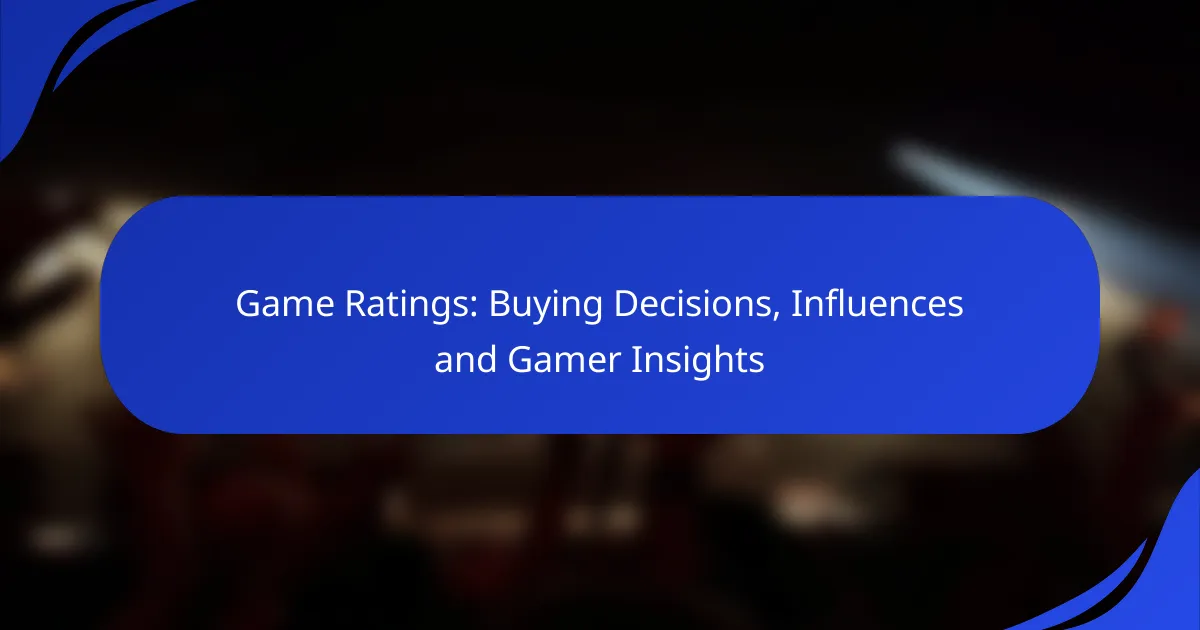Game ratings play a pivotal role in shaping consumer buying decisions by influencing perceptions and expectations of video games. Trusted rating systems like the ESRB and PEGI offer essential guidance on age appropriateness and content, helping gamers make informed choices. As a result, both critic and user ratings are critical factors that gamers consider when determining whether to purchase a title.

How do game ratings influence buying decisions?
Game ratings significantly impact buying decisions by shaping consumer perceptions and expectations. High ratings often lead to increased interest and trust in a game, while low ratings can deter potential buyers.
Impact of ratings on consumer behavior
Consumers frequently rely on game ratings as a primary factor in their purchasing decisions. A game with a high rating can create a sense of confidence, prompting buyers to invest their money, while a low rating may lead to hesitation or abandonment of the purchase altogether.
Additionally, gamers often seek recommendations from peers and online reviews, where ratings play a crucial role in influencing opinions. The social proof provided by high ratings can enhance a game’s appeal, making it more likely to be chosen over competitors.
Correlation between ratings and sales
There is a strong correlation between game ratings and sales figures. Games that receive high ratings tend to achieve better sales performance, often exceeding expectations in their launch periods. This trend is particularly evident in the first few weeks after release, where positive reviews can lead to a surge in purchases.
Conversely, games with low ratings may struggle to gain traction in the market. Sales can drop significantly if initial reviews are unfavorable, highlighting the importance of maintaining a good rating to ensure ongoing consumer interest.
Examples of popular games with high ratings
Several games have achieved remarkable success due to their high ratings. Titles like “The Legend of Zelda: Breath of the Wild” and “The Witcher 3: Wild Hunt” consistently receive top scores from critics and players alike, contributing to their status as bestsellers.
These games not only showcase exceptional gameplay and storytelling but also benefit from robust marketing strategies that leverage their high ratings. As a result, they serve as prime examples of how ratings can drive both consumer interest and sales success in the gaming industry.

What are the most trusted game rating systems?
The most trusted game rating systems are the Entertainment Software Rating Board (ESRB) and the Pan European Game Information (PEGI). These systems provide guidelines to help consumers make informed decisions about video game content based on age appropriateness and content descriptors.
ESRB rating system overview
The ESRB rating system is widely used in North America and assigns ratings based on the content of video games. Ratings range from “E for Everyone” to “M for Mature,” with additional content descriptors that highlight specific themes, such as violence or strong language.
Each rating is determined through a review process that includes input from game developers and a thorough examination of the game’s content. This helps ensure that parents and gamers can easily identify suitable games for different age groups.
PEGI rating system details
PEGI is the primary rating system in Europe, providing age ratings from 3 to 18. The system includes descriptors that indicate the presence of potentially sensitive content, such as “Violence,” “Bad Language,” or “Fear.” This helps consumers understand the nature of the game before making a purchase.
PEGI ratings are enforced in many European countries, and compliance is often required for games sold in retail stores. The system aims to protect younger audiences by guiding parents and guardians in selecting appropriate games.
Comparison of ESRB and PEGI
While both ESRB and PEGI serve similar purposes, there are key differences in their approach. ESRB ratings focus more on content descriptors, while PEGI emphasizes age appropriateness alongside content warnings.
For example, an ESRB rating of “T for Teen” might indicate some violence, while a PEGI rating of 12 could suggest the game contains moderate violence but is suitable for players aged 12 and older. Understanding these nuances can help consumers choose games that align with their values and preferences.

How do gamers perceive game ratings?
Gamers perceive game ratings as a crucial factor in their purchasing decisions, often relying on these scores to gauge the quality and enjoyment of a game. Ratings from critics and users alike can significantly influence whether a gamer chooses to buy or skip a title.
Gamer trust in ratings
Trust in game ratings varies among gamers, with many viewing critic scores as more reliable than user-generated reviews. This skepticism stems from concerns about potential biases, such as marketing influence or paid promotions. Gamers often look for transparency in how ratings are calculated to build confidence in the scores they see.
To enhance trust, some gamers prefer aggregators that compile ratings from multiple sources, providing a broader perspective. This approach helps mitigate the impact of outlier reviews and offers a more balanced view of a game’s quality.
Influence of user reviews
User reviews play a significant role in shaping gamers’ perceptions, often reflecting personal experiences that resonate more than critic reviews. Many gamers check user feedback to understand the game’s community reception, gameplay mechanics, and potential issues. This peer input can sway decisions, especially for niche titles.
Gamers should be cautious, however, as user reviews can be influenced by factors like hype or backlash. It’s beneficial to look for patterns in reviews rather than focusing solely on individual comments, as this can provide a clearer picture of the game’s strengths and weaknesses.
Impact of social media on perceptions
Social media has transformed how gamers perceive game ratings by facilitating real-time discussions and sharing of opinions. Platforms like Twitter, Reddit, and YouTube allow gamers to express their views and engage with others, amplifying the impact of ratings. Viral posts or videos can quickly sway public opinion, making social media a powerful tool in shaping perceptions.
Gamers should consider the context of social media discussions, as trends can shift rapidly. Engaging with diverse sources and communities can provide a more comprehensive understanding of a game’s reception beyond just the ratings. This holistic view can lead to more informed purchasing decisions.

What factors affect game ratings?
Game ratings are influenced by various factors, including gameplay mechanics, graphics, sound quality, and community feedback. These elements collectively shape a player’s experience and can significantly impact their purchasing decisions.
Gameplay mechanics and design
Gameplay mechanics refer to the rules and systems that govern how a game operates. A well-designed game should offer intuitive controls, engaging challenges, and a balanced difficulty curve. For instance, games that allow for both casual and competitive play often receive higher ratings due to their accessibility and depth.
When evaluating gameplay, consider how mechanics enhance player engagement. Features like cooperative play, skill progression, and innovative mechanics can elevate a game’s appeal. Look for games that have received praise for their unique design elements, as these often lead to better ratings.
Graphics and sound quality
Graphics and sound quality play a crucial role in the overall gaming experience. High-quality visuals can immerse players in the game world, while sound effects and music contribute to the atmosphere. Games that utilize advanced graphics engines or have distinctive art styles often receive higher ratings.
When assessing graphics, consider factors such as resolution, frame rate, and artistic direction. For sound, pay attention to voice acting, sound design, and the soundtrack. Games that excel in both areas tend to create a more memorable experience, leading to favorable reviews.
Community feedback and updates
Community feedback significantly impacts game ratings, as player reviews and discussions can highlight strengths and weaknesses. A game that actively engages with its community through forums and social media often benefits from constructive criticism and suggestions for improvement.
Regular updates and patches are essential for maintaining a game’s quality over time. Developers who listen to player feedback and address issues promptly can enhance their game’s reputation. Look for games that have a strong post-launch support system, as these are more likely to receive positive ratings from players.

How to choose games based on ratings?
Choosing games based on ratings involves assessing the scores given by critics and players to make informed buying decisions. Ratings provide a quick reference to gauge a game’s quality, but they should be considered alongside personal tastes and preferences.
Evaluating ratings for informed purchases
When evaluating ratings, consider both critic scores and user reviews. Critics often provide a professional perspective, while user ratings reflect the experiences of everyday gamers. Look for games with a solid average score, typically above 70%, as these are generally well-received.
Pay attention to the number of reviews as well; a game with a high rating but only a few reviews may not be as reliable as one with a lower score but many ratings. Platforms like Metacritic or OpenCritic aggregate scores, making it easier to compare different titles.
Using ratings alongside personal preferences
While ratings are useful, personal preferences should guide your final decision. Consider what genres you enjoy, such as action, RPG, or puzzle games, and look for titles that excel in those areas. A game rated highly in a genre you dislike may not be worth your time or money.
Additionally, read reviews to understand specific aspects of the game, such as story depth, gameplay mechanics, and graphics. This will help you determine if a highly-rated game aligns with your interests.
Tips for finding hidden gems
To discover hidden gems, explore games with lower ratings that still have positive user feedback. Often, niche titles may not attract mainstream attention but offer unique experiences. Look for games with a rating between 60% and 75% that have a substantial number of enthusiastic reviews.
Participating in gaming forums or communities can also lead you to underrated games. Gamers often share their personal favorites that may not have received high-profile marketing but deliver exceptional gameplay.

What are the emerging trends in game ratings?
Emerging trends in game ratings reflect a shift towards more nuanced evaluations that consider player experiences and community feedback. As gaming becomes increasingly social, the influence of various platforms and user-generated content is reshaping how ratings are perceived and utilized in buying decisions.
Influence of streaming platforms
Streaming platforms like Twitch and YouTube have a significant impact on game ratings by allowing gamers to share their experiences in real-time. Viewers often rely on these streams to gauge a game’s quality, leading to immediate shifts in public perception and ratings based on gameplay demonstrations and commentary.
For instance, a game that receives mixed reviews might see a surge in interest if a popular streamer showcases it positively. This phenomenon can lead to spikes in sales, as viewers often trust the opinions of their favorite streamers over traditional reviews.
To leverage this trend, developers and marketers should consider collaborating with influencers to create engaging content that highlights their games. However, it’s crucial to ensure that these partnerships are authentic, as audiences can quickly detect insincerity, which may backfire and negatively impact ratings.





